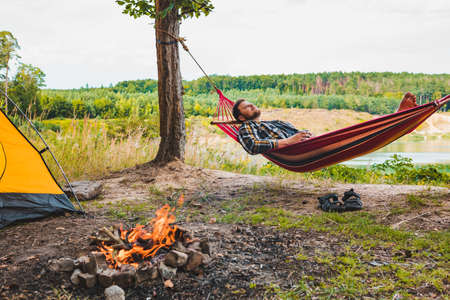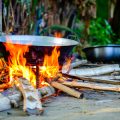Introduction: The Heart of Campfire Cooking
Few experiences capture the spirit of American outdoor culture quite like campfire cooking. From the rugged Rockies to the sandy shores of the Atlantic, gathering around a crackling fire to prepare and share a meal is more than just a means of sustenance—it’s a cherished tradition that brings people together, creates lasting memories, and celebrates regional flavors. Throughout history, campfires have been the heart of adventure, whether fueling pioneers on the Oregon Trail or serving as the centerpiece for modern family camping trips in national parks. As we journey across the United States, we’ll explore how diverse communities have shaped their own unique campfire cooking traditions, each reflecting local ingredients, cultural influences, and beloved recipes passed down through generations. Whether it’s roasting marshmallows for s’mores under star-filled skies or slow-cooking fresh-caught fish by a mountain stream, campfire cuisine tells the story of America’s connection with the land—and with each other. This article will take you on a flavorful cross-country road trip through regional recipes and stories that define campfire cooking from coast to coast.
2. Smoky Flavors of the Pacific Northwest
The Pacific Northwest is famous for its lush forests, rugged coastline, and an abundance of fresh ingredients that inspire unique campfire cuisine. Regional campers embrace a cooking style that highlights the area’s signature smoky flavors, often using locally sourced wood and ingredients that reflect the region’s natural bounty.
Signature Campfire Ingredients
| Ingredient | Why It’s Special |
|---|---|
| Cedar Planks | Used to impart a distinctive smoky aroma to fish, especially salmon. |
| Wild Salmon | Fresh from local rivers; prized for its rich flavor and texture. |
| Huckleberries | A native berry, celebrated in both sweet and savory dishes. |
| Mushrooms (Chanterelle, Morel) | Foraged in local forests, adding earthy depth to meals. |
Cedar-Planked Salmon: A Regional Staple
No discussion of Pacific Northwest campfire cooking is complete without cedar-planked salmon. Campers soak cedar planks in water before placing them over the fire, then lay fresh salmon fillets seasoned with sea salt, brown sugar, and dill on top. As the wood smolders, it infuses the fish with a subtle smokiness—a method passed down through generations. According to longtime camper Jake from Oregon: “Cooking salmon this way is more than a meal; it’s a tradition. The aroma brings everyone around the fire.”
Recipe Snapshot: Cedar-Planked Salmon
- Prep Time: 15 minutes (plus soaking plank)
- Cook Time: 20-25 minutes over medium campfire heat
- Flavor Profile: Smoky, slightly sweet, herbaceous
- Pro Tip: Serve with grilled seasonal vegetables or wild rice pilaf.
Huckleberry Delights and Sweet Memories
The wild huckleberry is another star ingredient found in countless regional treats—from pancakes at breakfast to cobblers enjoyed under the stars. Local campers fondly recall gathering huckleberries along trails before adding them to simple batters cooked in cast iron pans over glowing embers. Camp counselor Melissa from Washington shares: “Making huckleberry cobbler is our end-of-summer ritual. Everyone helps pick berries—it’s as much about the story as it is about dessert.”
Packed with Flavor: Popular Huckleberry Recipes at Campfires
| Dessert Name | Main Ingredients |
|---|---|
| Huckleberry Cobbler | Fresh huckleberries, biscuit dough, sugar, butter |
| Huckleberry Pancakes | Pancake mix, eggs, milk, wild huckleberries |
| Huckleberry Jam on Toast | Bread slices, homemade jam from handpicked berries |
The campfire traditions of the Pacific Northwest celebrate more than just food—they’re about forging connections with nature and each other. Whether savoring cedar-planked salmon or sharing stories over huckleberry desserts, every meal is a taste of regional heritage passed from one generation of campers to the next.
![]()
3. Southwestern Sizzle: From Chili to Cast Iron
The American Southwest is a region where culinary tradition meets fiery flavor, and nowhere is this more evident than around the campfire. Southwestern campfire cooking is defined by its bold spices, use of native ingredients, and techniques passed down through generations. Whether you’re savoring a pot of smoky chili, biting into warm Navajo fry bread, or grilling over fragrant mesquite wood, each meal tells a story of heritage and hospitality.
Classic Campfire Chili
No Southwestern campout is complete without a hearty pot of chili simmering over the flames. While recipes vary from Texas-style beef chili with no beans to New Mexico’s green chile stew, the essentials remain the same: robust flavors, plenty of peppers, and that unmistakable campfire smokiness. Traditionally cooked in cast iron Dutch ovens, chili becomes a communal dish—perfect for sharing stories under the stars.
Navajo Fry Bread: A Cultural Staple
Navajo fry bread holds deep cultural roots among Indigenous communities in the Southwest. Made from simple ingredients—flour, water, salt, and baking powder—this golden, puffy bread is fried in a cast iron skillet right over the campfire. It can be enjoyed on its own or topped with savory ingredients like beans and cheese for “Indian tacos.” The act of making fry bread together often sparks conversations about history and resilience.
Mesquite Wood Grilling
Grilling with mesquite wood is another iconic Southwestern technique that infuses food with a distinct smoky-sweet flavor. From steaks and skewers to vegetables and corn on the cob, mesquite embers add depth to every bite. Many campers swear by this method for its authenticity and unmistakable taste.
Southwestern Campfire Favorites
| Recipe | Main Ingredients | Signature Flavor | Tradition/Story |
|---|---|---|---|
| Chili | Beef or beans, chili peppers, tomatoes, spices | Smoky & spicy | A communal meal symbolizing warmth and togetherness |
| Navajo Fry Bread | Flour, water, baking powder, salt, oil | Crispy outside, soft inside | A symbol of resilience and cultural identity |
| Mesquite-Grilled Skewers | Meat (beef/chicken), veggies, mesquite wood smoke | Earthy & aromatic | A nod to traditional open-fire grilling methods |
Sitting around a Southwestern campfire isn’t just about satisfying hunger—it’s about connecting with the land and people who have shaped these time-honored traditions. Each meal carries flavors as vibrant as the desert sunset and stories as enduring as the mesas themselves.
4. Midwestern Comforts Around the Fire
The Midwest is the heartland of America, and its campfire cooking traditions are deeply rooted in community and family. Here, gatherings around a crackling fire often mean sharing stories, laughter, and hearty meals that warm both body and soul. Midwesterners take pride in their simple yet delicious recipes, many of which have been passed down for generations at lakeside campgrounds and forested retreats.
Hobo Packets: A Campfire Classic
No Midwest camping trip is complete without hobo packets—foil-wrapped bundles filled with meat, potatoes, vegetables, and seasonings. This meal is as versatile as it is easy to prepare, making it a favorite for families and groups. Everyone can customize their own packet before tossing it onto the coals, ensuring a personalized feast every time.
| Typical Ingredients | Flavor Variations |
|---|---|
| Ground beef or chicken Potatoes Carrots Onions Butter |
Italian herbs BBQ sauce Cajun spices Soy sauce & ginger |
Sweet Corn Roasts: Celebrating the Harvest
The Midwest’s fertile soil yields some of the nation’s best sweet corn, and roasting ears of corn over a campfire is a beloved late-summer tradition. Families shuck fresh corn together, soak the husks, then roast them over open flames until they’re smoky and tender. The result is a taste of summer that brings everyone back for seconds.
Lakeside Storytelling Traditions
Campfires beside the region’s many lakes set the stage for storytelling—a cherished custom in Midwest culture. Elders share tales from their youth, recounting fishing adventures, wildlife encounters, and even local legends about mysterious creatures lurking in the woods. These stories foster bonds between generations and keep family histories alive around the glow of the fire.
Midwest Campfire Comforts at a Glance
| Tradition | Description | When Enjoyed |
|---|---|---|
| Hobo Packets | Customizable foil meals cooked in hot coals | Dinner time on cool evenings |
| Sweet Corn Roasts | Corn roasted in husks over open flames | Late summer harvest season |
| Lakeside Storytelling | Telling family tales and local legends by the fire | Dusk into nightfall |
Whether it’s savoring a perfectly roasted ear of corn or listening to stories echo across still lake waters, Midwestern campfire cooking is all about togetherness. These traditions embody the warmth, generosity, and resilience of America’s heartland.
5. Southern Hospitality: Dutch Ovens and Cobblers
The American South is famous for its warm hospitality, and nowhere is that spirit more alive than around a glowing campfire. Southern campers have long relied on cast iron cookware, especially the versatile Dutch oven, to whip up comforting meals under the open sky. Sharing food is at the heart of every Southern gathering, making each meal a celebration of tradition and togetherness.
Classic Campfire Dishes
| Dish | Main Ingredients | Cooking Method |
|---|---|---|
| Dutch Oven Stew | Beef or chicken, potatoes, carrots, onions | Slow-cooked over coals in a Dutch oven |
| Skillet Cornbread | Cornmeal, buttermilk, eggs, baking soda | Baked in a cast iron skillet over an open fire |
| Peach Cobbler | Fresh peaches, sugar, biscuit dough or cake mix | Baked in a Dutch oven with hot coals on top and bottom |
The Art of Dutch Oven Cooking
In the South, mastering the Dutch oven is almost a rite of passage. These heavy pots distribute heat evenly, making them perfect for hearty stews and baked treats alike. Local legends often tell of grandmothers passing down secret stew recipes or families holding friendly cobbler competitions at reunions. The aroma of bubbling stew or sweet cobbler wafting through camp brings everyone together.
A Beloved Recipe: Peach Cobbler by the Fire
No Southern campfire feast would be complete without peach cobbler. This beloved dessert captures the essence of summer and hospitality. Simply toss sliced fresh peaches with sugar and cinnamon, top with biscuit dough or cake mix, then bake it low and slow in a Dutch oven surrounded by glowing embers. The result? A golden, bubbly treat best enjoyed with friends beneath the stars.
Stories from the South
Many campers recall stories of sharing their first taste of skillet cornbread or swapping family recipes late into the night. It’s common to hear tales like the one about Uncle Joe’s legendary venison stew that drew neighboring campsites closer or how a surprise batch of peach cobbler turned a rainy evening into a cherished memory. In the South, campfire cooking isn’t just about food—it’s about fostering connection and creating stories to savor for years to come.
6. East Coast Classics: Clambakes and Smores
The East Coast is a tapestry of campfire cooking traditions, blending coastal bounty with mountain ingenuity. Generations have gathered on windswept beaches or deep in the Appalachian woods, creating iconic meals that reflect both the landscape and the local spirit. Whether you’re savoring a classic New England clambake or toasting s’mores beneath a canopy of stars, these traditions are as much about community as they are about food.
New England Clambakes: Coastal Celebration
A true East Coast experience, the New England clambake is more than just a meal—it’s an event. Traditionally held on the beach, families dig a pit, line it with hot stones and seaweed, then layer in fresh clams, lobster, corn on the cob, potatoes, and sometimes sausage. Everything steams together under a wet canvas tarp, infusing the food with smoky ocean flavor. This communal feast has roots stretching back to Native American practices and remains a highlight of summer gatherings.
| Clambake Essentials | Traditional Ingredients |
|---|---|
| Seafood | Lobster, clams, mussels |
| Vegetables | Corn on the cob, potatoes, onions |
| Flavor Boosters | Sausage, drawn butter, lemon wedges |
| Cooking Method | Pit-steamed with seaweed over hot rocks |
Appalachian Campfire Recipes: Hearty and Homegrown
Head inland and you’ll find that Appalachian campfire cuisine is all about resourcefulness and comfort. Passed down through generations, recipes like skillet cornbread or foil-wrapped trout reflect both necessity and creativity. Local ingredients—wild ramps in spring or apples in fall—make each meal a tribute to the mountain landscape. Slow-cooked beans or hobo packets (meat and veggies sealed in foil) are favorites for their simplicity and robust flavor.
Classic Appalachian Campfire Dishes
- Skillet Cornbread: Baked over coals in cast iron for a crispy crust.
- Foil-Pack Trout: Fresh-caught fish stuffed with herbs and lemon.
- Camp Beans: Simmered with bacon or ham hock for smoky depth.
- Baked Apples: Hollowed out and filled with cinnamon sugar before roasting in embers.
S’mores: A Sweet American Tradition
No East Coast campfire is complete without s’mores—a gooey treat beloved by kids and adults alike. First appearing in Girl Scout manuals from the 1920s, this simple dessert layers toasted marshmallow and chocolate between graham crackers. Each bite is nostalgia wrapped in sticky fingers and laughter around the fire.
S’mores Variations Across the East Coast:
- Add peanut butter cups for extra richness.
- Swap dark chocolate for milk chocolate for a grown-up twist.
- Use flavored marshmallows or homemade cookies for regional flair.
The East Coast’s campfire cooking culture is defined by its diversity—celebrating both land and sea while honoring stories passed down through families. Whether you’re enjoying a seaside clambake or sharing s’mores by the firelight, these traditions continue to unite friends old and new along America’s Atlantic shores.
7. Conclusion: Preserving and Sharing the Tradition
Campfire cooking is more than just preparing food outdoors—it’s an enduring American tradition that connects us to our history, landscapes, and each other. Whether you’re simmering a Texas chili over mesquite coals, roasting marshmallows on a New England lakeshore, or flipping salmon on cedar planks in the Pacific Northwest, these regional recipes carry stories of family, friendship, and adventure. Passing down these recipes and tales isn’t just about preserving flavors; it’s about sharing values, teaching practical skills, and keeping the spirit of togetherness alive for generations.
As you gather around your next campfire, remember that each meal cooked in open air is part of a larger narrative—a tapestry woven from countless American voices. The act of sharing a meal outdoors invites conversation, laughter, and storytelling. It’s a moment when grandparents can teach grandchildren time-honored techniques, friends can swap their favorite s’mores hacks, and everyone can add their own twist to cherished classics.
Ways to Keep Campfire Cooking Traditions Alive
| Method | Description |
|---|---|
| Family Gatherings | Host regular campouts where recipes and stories are shared across generations. |
| Community Events | Join or organize local cookouts or camping festivals featuring regional dishes. |
| Recipe Journals | Create a family or community recipe book with space for memories and photos. |
| Online Sharing | Post your favorite campfire meals and stories on blogs or social media groups. |
| Cultural Education | Teach kids about the origins and significance of regional campfire foods. |
Your Turn: Share Your Campfire Stories!
We invite you to become part of this living tradition. What are your favorite campfire recipes? Do you have a memorable story from a night spent under the stars? Share your experiences in the comments below or with friends around your next fire. By passing along these traditions—through both food and storytelling—you help ensure that the warmth of campfire cooking continues to glow brightly across America for years to come.


